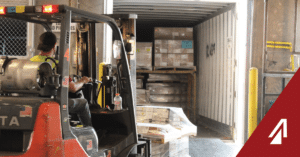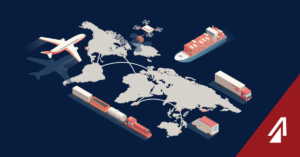Businesses are always looking for a way to get ahead – a step up in their industry that can set them apart from their competition. One of the strongest methods for getting ahead is to partner with a third-party logistics provider (3PL). These providers are able to create unique advantages and customizable options to help businesses succeed. Here are ten advantages a 3PL partner can provide to help businesses succeed.
Customer Service
3PLs, today are able to offer their customers superior service before, during, and after a load takes place – taking the burden off of the customer and leaving them to perfect their core competencies.
Before: Teams from engineering, procurement, and management will all work with the customer to build and design lanes, carrier options, pricing, and equipment needed to move the customer’s freight to their specifications. Then, supply chain managers and load planners will execute, schedule, and manage day-to-day loads.
During: Customer service teams follow the shipment from origin to destination – keeping the customer constantly updated for progress or issues.
After: 3PLs handle billing, document storage, and load audits for their customers; making sure the customer is satisfied and the shipments performed smoothly. They constantly evaluate historic loads to find areas for innovation and improvement.
Innovation
No portion of the supply chain is ever “settled” when working with a 3PL. 3PLs constantly work with their customers and teams to find areas of innovation and improvement. Competition in the marketplace is fierce, and 3PLs are on the forefront of improving their customers’ supply chains and logistics experience. They integrate new, stronger technology to provide faster, more reliable data for their customers. They look for ways to cut costs without sacrificing service; such as a new carrier or transportation service type. 3PLs consistently evaluate the customers’ supply chains and look for ways to improve.
Technology
One of the largest advantages 3PLs can offer is the access to cutting-edge technology for customers’ digital and physical supply chains. Some of the digital supply chain tools include:
• Collaborative transportation management systems – Customers can access and be as involved as they like with their loads. They can manually schedule loads or automate them, interact with shipments (parts, pieces, weight, load details, etc.), and create extensive reports with the raw data 3PLs collect.
• Tracking software/GPS – 3PLs can maintain pinpoint accurate shipment locations and updates with modern tracking systems. Fleet vehicles often come equipped with onboard GPS units, but 3PLs are able to harness owner operator information as well with mobile tracking devices using cell phone outputs.
• EDI/Data Transfer – Customers can automatically receive load tenders, updates, and other information via EDI.
Many 3PLs have access to physical supply chains technology tools like:
• Internet of things devices – 3PLs can monitor the exact parts going on any shipment and cross-reference them to the BOL with a handheld device.
• Long-rang RFID tracking – workers in 3PL yards or cross-docks can access loaded part information from outside of a closed trailer using RFID trackers on parts and containers.
Flexibility
3PLs offer their customers both macro and micro flexibility to make the loads operate smoothly –even in peak busy season or during driver shortages.
Macro: 3PLs help their customers create big picture solutions. They are able to shift and adapt processes, routes, or carrier contracts, and help their customers transition themselves to meet federal regulations.
Micro: Customers can rest assured that 3PLs are ready for last minute changes on a smaller scale as well. They can find last minute coverage for loads, change shipment directions en route, or recover freight in transit.
Whether is it a customer’s busy season, or if there is an unexpected crisis, 3PLs are there to provide alternatives and make the shipment run smoothly.
Save Time
Customers, partnering with 3PLs, can save significant amounts of time when it comes to scheduling loads or finding carriers. With collaborative transportation management software, customers can automate load scheduling for a regular day/time of the week, any other irregular schedule, or for when a part number is nearing a replenishment threshold. Using a 3PL, a customer can set it and forget it. More hands on users can manually request shipments with an SCM or through user-friendly features in the TMS.
Once the load is scheduled, customers can sit back and wait for the carriers to collect the freight. 3PLs have a deep carrier base of asset trucks, brokerage networks, contracted carriers, and single operators all over the country. No matter what the job is, 3PLs have an option for their customers. Most 3PLs have deep tribal knowledge of the marketplace carriers and have developed deep relationships with them – relationships their customers can take advantage of and use. Even with fewer drivers in the market or during the busier freight seasons, 3PLs are able to find what their customers need quickly and efficiently.
Save Money
Part of the tribal knowledge 3PLs possess is having the ability to get fair market prices for customers. They contract carriers on lanes or find additional freight for drivers to help bring down costs. That way, customers can avoid spot-bid markups or deadhead overages.
Another money saving advantage is that with most 3PLs, their customers only pay for what they use. Customers can save money on shipping LTL or by renting warehouse space – rather than purchasing or leasing the entire truck or facility. Each system can be tailored to a customer’s individual needs and budget.
Also, companies can save money by not investing in developing the technology, relationships, and infrastructure 3PLs already possess. They do not need to hire extra staff or designate resources into implementing multiple systems. 3PLs have the resources and systems companies need to make their supply chains run efficiently.
Risk Management
Partnering with a 3PL can help many companies alleviate the risk that shipping inherently possesses. Customers can form relationships with their 3PLs and have designated points of contact for scheduling loads or receiving information. They do not need to worry about where their freight is or if it will deliver on time.
Often, 3PLs have strict standards for the carriers that run their freight. These based on safety scores, track record, insurance, and customer preference. Only carriers who have been thoroughly vetted will be trusted with customer freight.
Insurance
Traditionally if freight is lost or damaged in transit, the customer is left responsible for the loss. Sometimes they can struggle to receive restitution from carriers. But, 3PLs carry significant insurance and can be held liable for lost or damaged freight – giving an added layer of protection to their customers. They employee full teams of workers to hear and investigate claims and give restitution for wrongdoings. Customers rest assured that if anything happens to their freight it will be made right.
Safety Certifications
Customers want to know that their freight is crossing borders safely and are not being maliciously used. The US Border Patrol and shipping community have partnered on several safety standards, like CTPAT, that signifies companies’ efforts to maintain and strengthen border security. Many top 3PLs have gone through the rigorous application process for these certifications and have proven their commitment to border security and their customer’s products.
Quality Assurance/Continued Improvement
Not only do 3PLs look to improve their customer’s supply chains, they look to improve themselves. Often, 3PLs will have Quality Assurance departments dedicated to monitoring the company’s processes and leading them to act more efficiently, more effectively, and more in line with customer requirements. Many constantly evaluate processes and procedures through grid-walks and other measures to ensure each process is operating at peak performance. They understand that their customers operate according to lean six sigma principles and express those principles themselves to fully integrate into their customers’ systems.
There are many reasons to consider partnering with a 3PL. The service, the savings, the security – each of these is important to making a supply chain strong and efficient and gives companies advantages over their competition. That is why so many companies are outsourcing their logistics to 3PLs.



